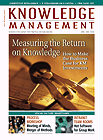
An Interview with Paul Strassmann
by Stuart Silverstone
Knowledge Management Magazine
April 1999
|
What's the key to implementing knowledge management?How is knowledge a form of capital?Ultimately all power derives from possession over resources, from property. The only difference is that until now everybody had it easy. They measured a piece of land or used a clock to measure labor as a form of property or measured financial resources. Now we have to start measuring property in terms of knowledge capital, which is as real as land.
Why is knowledge management important?Knowledge management has been with mankind for more than 8,000 years. The subject is only coming to popularity-or notoriety, as the case may be-as we try to justify further computerization that would claim to deliver the benefits of increased productivity. Computers have run out of demonstrated economic utility as an efficiency or productivity enhancement by virtue of the well-known "productivity paradox" which asserts that profitability and computer investments are unrelated. The question has now shifted to the subject of knowledge management, which perhaps will bail out and justify additional trillions of dollars worth of spending.
Can knowledge be measured?Typical corporations devote meticulous, attention to the analysis and accounting for tangible assets. But there is no process to measure and analyze investments in knowledge capital.Investments have always been based on rationing of limited goods-the limited amounts of land, labor and capital. With knowledge, it is feasible to create wealth from very little that is tangible. To measure that requires metrics that are repeatable and quantitatively definable in dollar terms. This calls for methods that are independently verifiable. Knowledge capital investment should be as much a part of the planning and budgeting process as financial capital.
What is your method of measurement?I calculate economic value-added, showing what customers are willing to pay for a firm's goods and services. Next we calculate the price for additional capital, benchmarking prices paid for comparable mergers and acquisitions. The next step is to calculate the economic value-added dollars (EVA) discounted over the life-cycle of the proposed knowledge investment, which yields a dollar estimate of a firm's knowledge capital.I also examine the employee count, calculating knowledge capital per employee as compared with salary. Where compensation is greater than the knowledge capital of employees, the company is paying for personnel who are value-detractors, not value-creators.
How does knowledge management affect markets?I check if the stock market is overvaluing a company. I compare the stock market valuations with the sum of the book value of the financial assets plus the calculated valuation of knowledge capital. If you add knowledge capital to the accounting book value, as listed in conventional financial reports, you get a good proxy for a composite valuation of the firm. This approach reflects the fact that knowledge capital is not only the result of a year's financial performance, but also of everything that has preceded it. One way of viewing knowledge capital is to see it as the principal out of which this year's economic value-added is derived.
What is the significance of the value?I analyze what is creating knowledge capital. To deal with this matter requires asking what influences one must manage in order to accumulate knowledge in a firm. Knowledge capital can be created only when you invest in something that has a lasting value, such as making a sales call-provided you establish a bond with the customer that reduces future sales expenses. If you make an unproductive sales call, it is an expense, not knowledge capital. Software may or may not he a form of knowledge creation, depending on whether the software gets scrapped or if it remains in place for a long time. I find that costly frequent software updates and expensive program maintenance is a form of planned destruction of knowledge capital.
What is your ranking survey?Clients' data allow me to compute knowledge capital for their benchmark peer groups. From analyzing thousands of corporations I've produced a knowledge capital ranking by industry and by country. I calculate the ratio of finance capital to knowledge capital. Finance capital exceeds knowledge capital in industries like mining and timber. These finance capital rich and knowledge capital poor firms account for less than 8% of corporations! Where firms deploy almost no finance capital and their valuation is based on knowledge capital, the ratio of knowledge capital to finance capital is as high as 400.
Who should be responsible for knowledge capital?The CKO is an attempt to circumvent the CIO because someone needs hold the fiduciary accountability for knowledge assets and the present CIOs are not likely to do that. The present generation of CFOs also do not have an inclination to become involved with the valuation of intangibles, since they already hold the fiduciary accountability for measurable financial assets.The future CKO should be an executive to certify the integrity, security and custody of a firm's knowledge assets as these assets become the most important components of shareholder value. My data show that U.S. corporations have four to eight times more knowledge assets than financial assets. Somebody has to account, at budget time and during shareholder meetings, for the prudent custody of these assets. The future CKO would have to assist in making the hard choices how to extract knowledge capital from a gain in the productivity of people, in terms of sustainable knowledge assets.
How do you expect these ideas to be applied?Financial markets will find it profitable to reward companies that accumulate knowledge capital as compared to companies that don't. The application of the idea that knowledge capital must be seen as a definable asset will be driven by demand, not by advocacy or preaching.
|